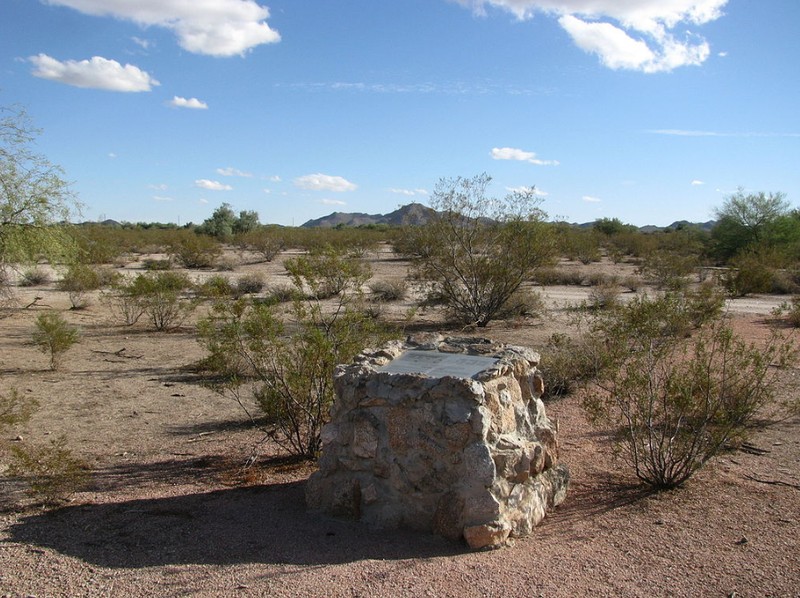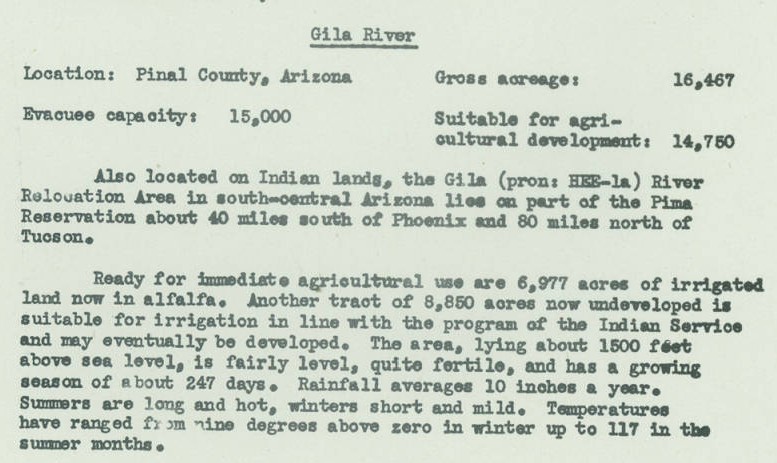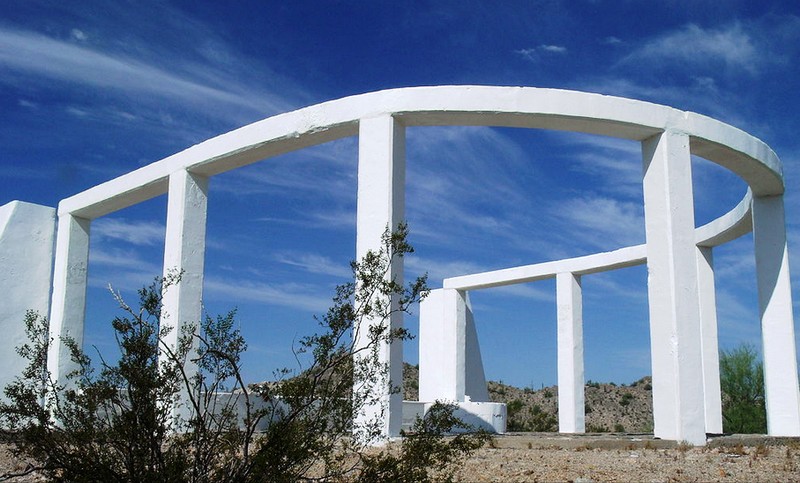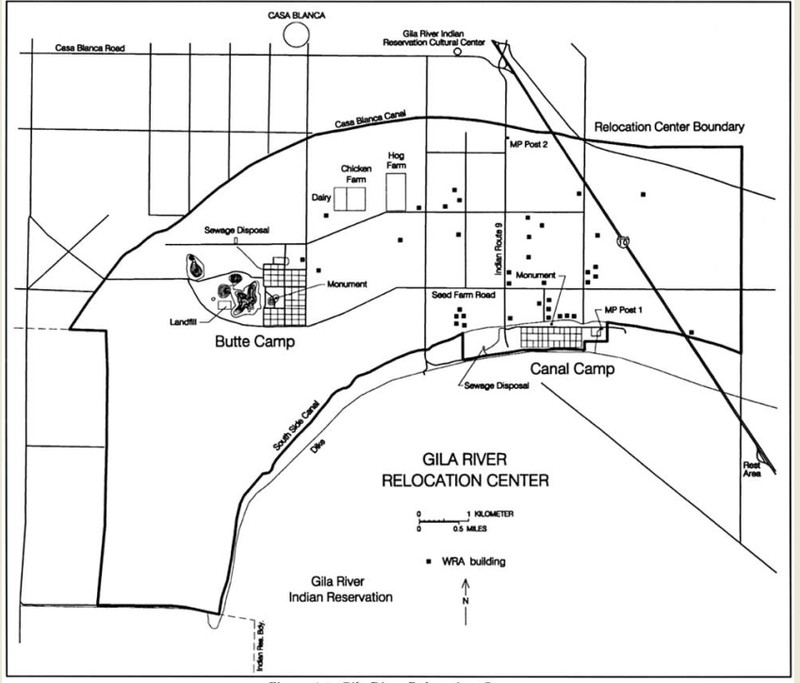Gila River Relocation Center
Introduction
Text-to-speech Audio
The Gila River Relocation Center, or Rivers Relocation Center, is one of the two World War II prison camps located on American Indian Reservations in Arizona at which over 13,000 Americans of Japanese descent were incarcerated. The land belonged to the Akimel O'otham and Maricopa Indians of the Gila River Indian Community. The camp operated from July 1942 to November 1945.
Because the Gila River Indian Community maintains sovereignty over and owns its land, visitors may not visit the former sites unless they have applied for and received a permit from the community.
Images
Canal camp monument at Rivers Relocation Center. Source: Wikicommons.

Description of Gila River Relocation Center. Source: War Relocation Authority, 1942.

Japanese American Honor Roll memorial at the former Gila River Relocation Center. Source: Wikicommons.

Gila River Relocation Center camp layout. Source: National Park Service.

Backstory and Context
Text-to-speech Audio
The War Department selected the Gila River Indian Community
as one of the two Arizona prison camps where Japanese Americans were incarcerated during World War II. The camp was named Rivers after Jim Rivers, the first Akimel O'otham killed in the First World War.
The sixteen thousand-five hundred-acre Rivers was divided into two camps: Camp One was named Canal, and Camp Two named Butte, based on their locations. The first inmates arrived at Canal in mid-July 1942 and were put to work preparing the camp in advance of the other inmates. Most of those incarcerated at Rivers came from the Central California regions, although there were inmates from Hawai'i and Southern California. The inmates in Canal exceeded the camp's capacity by the time Butte Camp opened in mid-August 1942, with Canal built for 4,800 inmates and Butte built for 10,000 inmates. It became Arizona's fourth-largest city, with a peak population of 13,348.
The inmates arrived during the height of the summer heat in July 1942, with recorded temperature between 100 to 105 degrees. The barracks had no insulation or air cooling systems, causing inmates to dig earthen basements beneath their barracks to escape the heat. Water from the Gila River was used to create fish ponds which helped cool the air and provide some beauty in the prison camp.
Gila River inmates produced most of the food for Canal and Butte, as well as for Poston, the Colorado River Relocation Center near Parker, Arizona. By 1944, Gila River was responsible for sending over four million pounds of produce to eight of the ten War Relocation Authority camps.
Barracks were used for churches, meeting rooms, libraries, and other community services. There was an active Japanese American Citizens League, as well as Boy Scouts, American Legion and other groups. Both Buddhist and Christian congregations held church services.
A major pastime was baseball. Kenichi Zemura, a Japanese-born professional baseball player in the Central Valley Fresno Nisei League and founder of the Nisei Baseball League throughout California, was incarcerated at Gila River. Zenimura coached the high school baseball team, the Gila River Eagles and organized a 32-team baseball league, building with his sons a baseball field with bleachers to sit 6,000 spectators in Butte Camp.
Eleanor Roosevelt made a surprise visit to the camp in 1943. Her observations in Collier’s Magazine on October 10, 1943, were that "a Japanese American may be no more Japanese than a German-American is German, or an Italian-American is Italian, or of any other national background. All of these people, including the Japanese Americans, have men who are fighting today for the preservation of the democratic way of life and the ideas around which our nation was built. We have no common race in this country, but we have an ideal to which all of us are loyal: we cannot progress if we look down upon any group of people amongst us because of race or religion."
Gila River Indian Community maintains sovereignty over the land of the former Rivers Relocation Center and visitors may not visit the former sites unless they have applied for and received a permit from the Community. The Gila River War Relocation Memorial is located north of Indian Route 24, west of Interstate 10, near Sacaton, the capitol of the Gila River Indian Community.
The sixteen thousand-five hundred-acre Rivers was divided into two camps: Camp One was named Canal, and Camp Two named Butte, based on their locations. The first inmates arrived at Canal in mid-July 1942 and were put to work preparing the camp in advance of the other inmates. Most of those incarcerated at Rivers came from the Central California regions, although there were inmates from Hawai'i and Southern California. The inmates in Canal exceeded the camp's capacity by the time Butte Camp opened in mid-August 1942, with Canal built for 4,800 inmates and Butte built for 10,000 inmates. It became Arizona's fourth-largest city, with a peak population of 13,348.
The inmates arrived during the height of the summer heat in July 1942, with recorded temperature between 100 to 105 degrees. The barracks had no insulation or air cooling systems, causing inmates to dig earthen basements beneath their barracks to escape the heat. Water from the Gila River was used to create fish ponds which helped cool the air and provide some beauty in the prison camp.
Gila River inmates produced most of the food for Canal and Butte, as well as for Poston, the Colorado River Relocation Center near Parker, Arizona. By 1944, Gila River was responsible for sending over four million pounds of produce to eight of the ten War Relocation Authority camps.
Barracks were used for churches, meeting rooms, libraries, and other community services. There was an active Japanese American Citizens League, as well as Boy Scouts, American Legion and other groups. Both Buddhist and Christian congregations held church services.
A major pastime was baseball. Kenichi Zemura, a Japanese-born professional baseball player in the Central Valley Fresno Nisei League and founder of the Nisei Baseball League throughout California, was incarcerated at Gila River. Zenimura coached the high school baseball team, the Gila River Eagles and organized a 32-team baseball league, building with his sons a baseball field with bleachers to sit 6,000 spectators in Butte Camp.
Eleanor Roosevelt made a surprise visit to the camp in 1943. Her observations in Collier’s Magazine on October 10, 1943, were that "a Japanese American may be no more Japanese than a German-American is German, or an Italian-American is Italian, or of any other national background. All of these people, including the Japanese Americans, have men who are fighting today for the preservation of the democratic way of life and the ideas around which our nation was built. We have no common race in this country, but we have an ideal to which all of us are loyal: we cannot progress if we look down upon any group of people amongst us because of race or religion."
Gila River Indian Community maintains sovereignty over the land of the former Rivers Relocation Center and visitors may not visit the former sites unless they have applied for and received a permit from the Community. The Gila River War Relocation Memorial is located north of Indian Route 24, west of Interstate 10, near Sacaton, the capitol of the Gila River Indian Community.
Sources
Roosevelt, Eleanor. To Undo a Mistake is Always Harder Than Not to Create One Originally. National Park Service. . Accessed April 10, 2018. http://www.digitalhistory.uh.edu/active_learning/explorations/japanese_internment/confinement_ethnic....
Gila River Relocation Center. National Park Service. . Accessed April 10, 2018. http://www.digitalhistory.uh.edu/active_learning/explorations/japanese_internment/confinement_ethnic....
Roosevelt, Eleanor. A Challenge to American Sportsmanship. The Eleanor Roosevelt Papers Project. October 16, 1943. Accessed April 10, 2018. https://www2.gwu.edu/~erpapers/documents/articles/challengetoamerican.cfm. Collier's 112
Leong, Karen. Gila River. Densho Encyclopedia. . Accessed April 10, 2018. http://encyclopedia.densho.org/Gila_River/#cite_note-ftnt_ref19-19. Arizona State University
Huso, William. "Gila River: A History of Relocation at the Gila River Relocation Center." . Published December 21, 1945. Calisphere, University of California. Report of Gila River Relocation Program Officer, http://content.cdlib.org/view?docId=kt8j49n9pt;NAAN=13030&doc.view=frames&chunk.id=d0e69&toc.depth=1...
Gila River Relocation Center. National Park Service. . Accessed April 10, 2018. http://www.digitalhistory.uh.edu/active_learning/explorations/japanese_internment/confinement_ethnic....
Roosevelt, Eleanor. A Challenge to American Sportsmanship. The Eleanor Roosevelt Papers Project. October 16, 1943. Accessed April 10, 2018. https://www2.gwu.edu/~erpapers/documents/articles/challengetoamerican.cfm. Collier's 112
Leong, Karen. Gila River. Densho Encyclopedia. . Accessed April 10, 2018. http://encyclopedia.densho.org/Gila_River/#cite_note-ftnt_ref19-19. Arizona State University
Huso, William. "Gila River: A History of Relocation at the Gila River Relocation Center." . Published December 21, 1945. Calisphere, University of California. Report of Gila River Relocation Program Officer, http://content.cdlib.org/view?docId=kt8j49n9pt;NAAN=13030&doc.view=frames&chunk.id=d0e69&toc.depth=1...
